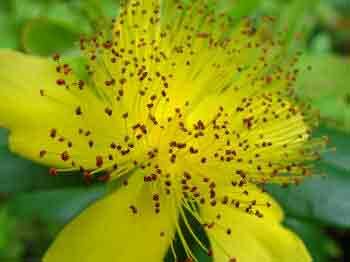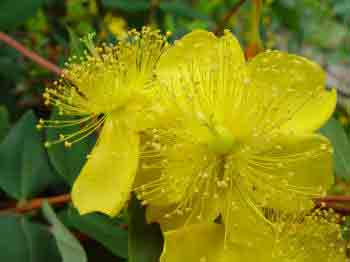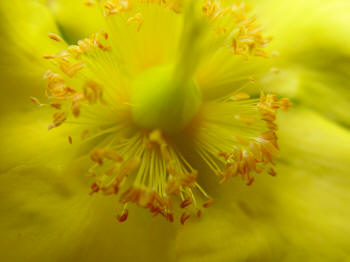Hypericum St John's Wort or Rose of Sharon
The shrub section of Hypericum has a few useful and accommodating varieties which will flourish in a wide range of garden situations. (There are also a few ‘perennial’ types which we deal with elsewhere.)
Hypericums are often seen in public areas as ground cover plants and not too well cared for. However, as a garden shrub, they can make a useful contribution - and spectacular display - in almost any garden soil, or in sun or shade. In fact, there is almost certain amount tk be a Hypericum for any of the many difficult places which most of us tend to have somewhere in the garden.
All shrub types of Hypericum have golden yellow flowers, some with spectacular masses of protruding stamens, and some with attractive seed fruits - gold, red or black.
There are two basic forms in relation to growth habit and height. One type being low growing and rapidly spreading by underground stems, and the other being the clump forming shrubby types, that will grow to a height of one metre with a similar spread.
 As with their varied wild habitats throughout the world, Hypericums
are suitable for planting in either slightly acid, neutral, or alkaline
soils and will not baulk at being planted in areas of moderate shade,
slightly damp areas, or hot sunny banks.
As with their varied wild habitats throughout the world, Hypericums
are suitable for planting in either slightly acid, neutral, or alkaline
soils and will not baulk at being planted in areas of moderate shade,
slightly damp areas, or hot sunny banks.
All of the shrubby types are suitable for planting in borders, woodland, beds, or at the base of dry walls. The lower growing variety we include here - Hypericum calycinum - is best used as a mass planting ground cover subject; a use for which it has no equal in the right situation.
Herbal Hypericum
Hypericum is used (as St John’s Wort) in herbal medicine. It is extracted from one species – being Hypericum perforatum – a perennial type. The herbal preparation is sometimes packaged as ‘Hypericum’ rather than, or as well as, St John’s Wort. This information is simply to prevent you thinking that all Hypericums are herbs. They are not, and certainly not the shrubby types we talk of here.
Growing Hypericum
Image of Hypericum calycinum
The growing conditions previously listed are suitable for most Hypericum, and in particular, either full sun or partial shade. The varieties mentioned here are all fully hardy in most winters, especially once matured and settled in for a few years.
Propagation of Hypericum
Seed of Hypericum is generally available for sale, but it is also possible to collect and save your own seed. Collect the seed as soon as ripe - but NOT before, or it will not be viable.
In this case, the seed should be surface-sown in pots or containers as soon as harvested – early autumn. Overwinter in a cold frame or unheated glasshouse.
Germination will probably take place before the onset of winter, or in the following early spring.


Hypericum kouytchense left anf Hypericum 'Hidcote' Right
It is possible to grow shrub Hypericums from either softwood cuttings or semi-ripe cuttings in the summer. The latter are more successful.
The low growing Hypericum calycinum freely roots underground stems which can be removed and potted up in bunches. The shrubby types can also be layered into the soil, by means of pegging down a few of the stems in early summer and severing once rooted.
Care needs to be taken in the first year as young plants, but afterwards they are relatively easy to grow on.
Problems with Hypericum.
No pests worth mentioning, but Hypericum calycinum is prone to leaf rust – which is unsightly, but not normally lethal. Prevention with a fungicidal spray is best. Some of the shrubby types also suffer from rust to a lesser extent, and Hypericum x inodorum in particular can be spoiled.
Low growing Varieties.
Hypericum calycinum – is superb as a ground cover plant, and best in full sun or partial shade.
Shrub Forms of Hypericum
Hypericum x inodorum ‘Elstead’ is well planted, and has broad leaves, and upright growth, bright golden yellow flowers, and pink to red fruit held above the foliage in late summer.
Hypericum x inodorum ‘Ysella’ has golden foliage – lime green if too shaded! 1.2m max
Hypericum kouytchense. Sometimes sold as Hypericum Sungold. Arching shoots with golden bowled flowers, giving way to almost pyramid shaped red fruits in late summer.
Hypericum Hidcote - Bushy normally evergreen, and with large attractive flowers. No fruits to speak of. A good variety
Hypericum patulum ‘Henryi’ is an old well tried and tested favourite – having cupped yellow flowers, and semi-evergreen or fully evergreen foliage. 1.2 meters normally though older specimens maybe 1.5m.
Best Selling Gardening Products
Popular Gardening Sections

Problems
Identify Weeds in The Garden - How to deal with weeds. Diseases and Pest which harm your garden and plants, learn how to prevent, deter and erradicate your garden problems.
Garden Problems
Pruning
Pruning Guide. Shrubs flower better with correct pruning. Many illustrations and examples of what to do - and when. Includes evergreens, roses, flowering shrubs, spring flowering shrubs and pruning for stem effect. This is our most viewed and comprehensive section,
Pruning
Gardening Businesses
Gardening Businesses listed in the UK counties and USA states. County and State Listings of businesses involved in Garden supplies and services. If you wish to be added to the Directory, please send us your information. Having problems, use the search box
Businesses
Gardening
In this section you will learn about Gardening Basics, Containers, Landscaping, Propagation and Soil.
Gardening
Gardening Gifts
Gardening Gifts and Reviews, Read Before you Buy
- Gardening Gifts Ideas
- Gifts For Her
- Gifts For Men
- Power Tool Gifts
- Cheap Gifts
- Personalised Gifts
- Wildlife Gifts
- Family Gifts



